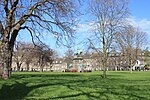Dean Bridge

The Dean Bridge spans the Water of Leith in the city of Edinburgh on the A90 road to Queensferry on the Firth of Forth. It carries the roadway, 447 feet (136 m) long and 39 feet (12 m) broad, on four arches rising 106 feet (32 m) above the river. The bridge was one of the last major works before retirement of the bridge designer, civil engineer Thomas Telford, and was completed in 1831 when he was seventy-three years old.Before the bridge was built the river had been crossed since medieval times at a ford, later by a single-arch stone bridge near the same spot, at the foot of Bell's Brae in the Dean Village. The private Dean Gardens lie under the east side of the bridge on the north bank of the Water of Leith.
Excerpt from the Wikipedia article Dean Bridge (License: CC BY-SA 3.0, Authors, Images).Dean Bridge
Water of Leith Walkway, City of Edinburgh Stockbridge
Geographical coordinates (GPS) Address External links Nearby Places Show on map
Geographical coordinates (GPS)
| Latitude | Longitude |
|---|---|
| N 55.9529 ° | E -3.2142 ° |
Address
Dean Bridge
Water of Leith Walkway
EH3 6TS City of Edinburgh, Stockbridge
Scotland, United Kingdom
Open on Google Maps










